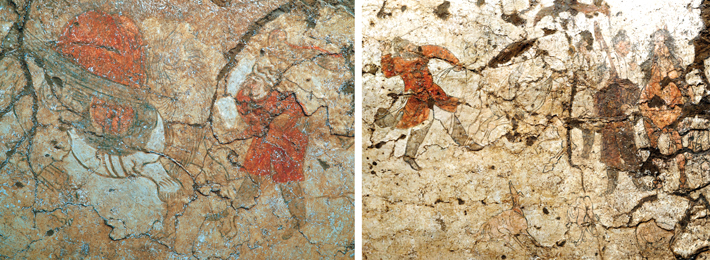Beast Masters
May/June 2021
 Murals unearthed in a tomb in northwestern China’s Shaanxi Province portray two hardworking professionals struggling to control animals. Dating to the early Tang Dynasty (A.D. 618–907), the murals depict the men with features and clothes typical of the Sogdians, an Iranian people from Central Asia, many of whom lived in China. (See “A Silk Road Renaissance.”) In one mural, a Sogdian merchant confronts a camel laden with goods as it throws its head back. In another scene, a Sogdian groom attempts to tame a wild horse as two greyhounds, a breed still popular in the area today, look on. “These murals show vivid facial expressions and gestures of both people and animals,” says archaeologist Ming Li of the Shaanxi Academy of Archaeology in Xi’an.
Murals unearthed in a tomb in northwestern China’s Shaanxi Province portray two hardworking professionals struggling to control animals. Dating to the early Tang Dynasty (A.D. 618–907), the murals depict the men with features and clothes typical of the Sogdians, an Iranian people from Central Asia, many of whom lived in China. (See “A Silk Road Renaissance.”) In one mural, a Sogdian merchant confronts a camel laden with goods as it throws its head back. In another scene, a Sogdian groom attempts to tame a wild horse as two greyhounds, a breed still popular in the area today, look on. “These murals show vivid facial expressions and gestures of both people and animals,” says archaeologist Ming Li of the Shaanxi Academy of Archaeology in Xi’an.
Li’s team found the murals in the tomb of a seventh-century A.D. equestrian official named Shanda Kang. According to Kang’s epitaph, also found in the tomb, he managed horses in the ancient capital of Xianyang. This was a prominent position because horses were vital to the Tang Dynasty military. His family name, Kang, which is related to the name of the Sogdian city of Samarkand in modern-day Uzbekistan, implies that Kang was probably the descendant of Sogdian immigrants, though he was born in China and lived there all his life. Kang’s tomb was located near the starting point of the Silk Road, which functioned in part thanks to the Sogdians’ mercantile and equestrian know-how.